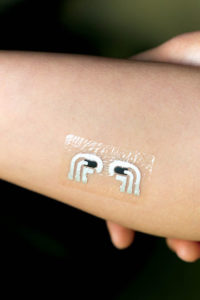
Photo: University of California, San Diego
Diabetics monitor blood glucose levels with devices that draw blood, analyze data and display numbers that signal levels outside the normal range. The “finger pokes” are never comfortable, nor are the sore fingers and tiny adhesive bandages that result from a glucose monitoring routine. University of California, San Diego, graduate student Amay Bandodkar and colleagues in the NanoEngineering Department and Center for Wearable Sensors at the Jacobs School of Engineering had a better idea. The researchers developed a temporary tattoo printed with electrodes and sensors made of low-cost silver and silver chloride inks, conductive carbon and an insulating agent. One electrode is coated with an enzyme that reacts with glucose, allowing the noninvasive flexible tattoo to detect glucose levels.
Mild electrical stimulation to the skin forces sodium ions in cell fluids to migrate to the tattoo electrodes. The ions carry glucose in cell fluids, which produces an electrical charge that corresponds to the glucose levels in the blood. The concentration of glucose extracted by the tattoo is 100 times lower than the corresponding blood level, so the glucose sensor has to be highly sensitive and specific. At the moment, the tattoo doesn’t provide a numerical readout, but the Center for Wearable Sensors has researchers developing readouts with “Bluetooth capabilities to send this information directly to the patient’s doctor in real time or store data in the cloud,” says Bandokar. Temporary tattoos last a day—but cost only a few cents to produce. For more, see the research article on ACS Publications in the journal Analytical Chemistry.
 TEXTILES.ORG
TEXTILES.ORG


